Introduction: An In-Depth Look at Seborrheic Dermatitis
Seborrheic dermatitis is a widespread skin condition that affects millions of people globally. This article will provide a detailed examination of seborrheic dermatitis, including its top 10 symptoms, what it is, and how it’s diagnosed and treated. By the end of this article, you’ll have a solid understanding of this skin disorder and how to manage it effectively. So, let’s dive right in!
Seborrheic dermatitis is a chronic, inflammatory skin condition that mainly affects the scalp, face, and upper body. It’s characterized by red, scaly patches and can cause itching and discomfort. Although the exact cause is still unknown, it’s believed to be linked to an overgrowth of yeast on the skin and an overactive immune response. In this article, we will explore the top 10 symptoms of seborrheic dermatitis, providing you with valuable information on this common skin condition.
As we continue our discussion, we will also look at various treatment options and preventative measures to help manage seborrheic dermatitis effectively. With this knowledge, you’ll be better equipped to recognize the signs and symptoms of this skin condition and seek appropriate medical care when necessary.
What is Seborrheic Dermatitis?
Seborrheic dermatitis is a chronic, inflammatory skin condition that affects the areas of the body with a high concentration of oil-producing glands. These areas include the scalp, forehead, cheeks, and other parts of the face and upper body. The condition often presents itself as red, scaly patches on the skin, which can be white or yellowish and may flake off, causing dandruff-like symptoms.
Symptom 1: Red, Scaly Patches

The first symptom of seborrheic dermatitis is the presence of red, scaly patches on the skin. These patches are a result of the inflammation and irritation caused by the condition. The affected areas become red and swollen, with the skin thickening and developing scales.
The scales themselves are usually white or yellowish in color and can vary in size. They can be either fine and flaky, resembling dandruff, or thicker and more noticeable. The severity of the scaling can differ from person to person and may change over time as the condition progresses or responds to treatment.
These scaly patches are most commonly found on the scalp, but they can also appear on the face, particularly around the eyebrows, nose, and ears. In more severe cases, seborrheic dermatitis can also affect the chest, back, and other areas of the body with a high concentration of oil-producing glands.
When left untreated, the red, scaly patches can become itchy and painful, leading to further discomfort and potentially causing secondary infections due to scratching. Early treatment is crucial to minimize these complications and improve the overall quality of life for those affected by seborrheic dermatitis. (1)